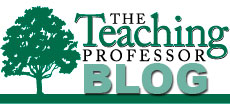Teaching and learning. For decades, we focused almost exclusively on the teaching side of things. More recently, we’ve been paying attention to learning, and that’s a good thing. However, we shouldn’t be thinking about one without the other—they’re both important and inseparably linked.
 The August-September issue of The Teaching Professor newsletter includes highlights from a couple of recent studies that get us back to teaching and those teacher qualities that students consistently say can make a difference in how they learn.
The August-September issue of The Teaching Professor newsletter includes highlights from a couple of recent studies that get us back to teaching and those teacher qualities that students consistently say can make a difference in how they learn.
There’s no shortage of lists identifying desirable teacher characteristics. Researchers have been generating them since the 1930s. Moreover, the same or very similar characteristics keep showing up on list after list. This means we can profitably look at any list so long as we don’t assume it’s the only or best delineation of those teacher qualities made visible in the delivery of instruction and during interactions with students.
Here’s a collection of characteristics that was compiled with attention paid to three criteria: 1) the behavior or characteristic increases learning outcomes; 2) the behavior or characteristic is “historically prominent” in the communication education literature (communication education has a long history of impressive research and scholarship on teaching); and 3) the list includes a wide variety of teacher qualities.
What’s on the list below appears in random order. In the study, students were asked to prioritize these qualities. For teachers just starting a new academic year, it’s the whole list that merits review, self-appraisal, and recommitment. The questions for teachers involve the extent to which their teaching demonstrates these characteristics and via what instructional behaviors, policies, and practices they are being communicated.
- Assertive – the teacher has a strong personality, is independent, competitive, and forceful
- Responsive – the teacher has compassion, is helpful, sincere, friendly, and sensitive to student needs
- Clear – the teacher presents content in ways that students can understand, answers questions, has clear course objectives
- Relevant – the teacher uses examples, explanations, and exercises that make the course content relevant to students’ careers and personal goals
- Competent – the teacher is a content expert, intelligent, and knows how to teach
- Trustworthy – the teacher is honest, genuine, and abides by ethical standards
- Caring – the teacher cares about students, understands them, and has their best interests at heart
- Immediate – the teacher’s nonverbal behaviors are expressive; the teacher smiles, nods, uses gestures, makes eye contact, and doesn’t speak in a monotone
- Humorous – the teacher uses humor frequently
- Discloses – the teacher reveals an appropriate amount of personal information when it’s relevant to the topic
I still regularly hear teaching described as a gift; some teachers are endowed with it and then there’s the rest of us. We all know teachers who are exceptionally effective and they sometimes brush off their excellence with comments about being lucky or just doing what comes naturally. But most teachers who are good at what they do have worked hard to get that way and continue to improve and refine their teaching. They take their professional development seriously and believe they can always get better.
Furthermore, the qualities students identify argue against the idea of teaching as a gift. None of the characteristics on this list is something bestowed upon persons at birth. All of them involve learned behaviors that can be demonstrated and communicated in different ways, and no teacher can do them all equally well. No, good teaching is not a birthright; it grows out of sets of characteristics that can be developed and continuously improved by everyone who teaches.
How we teach makes a huge difference in the learning experiences students have in our courses, in higher education, and, ultimately, in their lives beyond. And for that reason, we should be simultaneously devoted to improving learning and to developing our teaching.
Reference: Goldman, Z. W., Cranmer, G. A., Solitto, M., Labelle, S., and Lancaster, A. L. (2017). What do college student want? A prioritization of instructional behaviors and characteristics. Communication Education, 66 (3), 280-298.
Review additional articles on characteristics of effective teachers:
- Six Things That Make College Teachers Successful
- Teacher Behaviors Checklist
- Teaching Effectiveness: The Definitions of Teachers and Students
- Nine Characteristics of a Great Teacher

